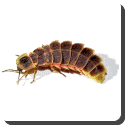 Glowworm — Glowworm (or glow-worm) is the common name for various different groups of insect larvae and adult larviform females which glow through bioluminescence. They may sometimes resemble worms, but all are insects (Arachnocampa being a fly and all the others being beetles). The major families are:
Glowworm — Glowworm (or glow-worm) is the common name for various different groups of insect larvae and adult larviform females which glow through bioluminescence. They may sometimes resemble worms, but all are insects (Arachnocampa being a fly and all the others being beetles). The major families are:
Lampyridae (fireflies), found around the world. The wingless adult female is the glowworm of literature, especially Lampyris noctiluca (the “Glow-worm” proper of British English) found in the most of Europe including the British Isles. In this species the male flies but does not glow. By contrast Firefly in the United Kingdom means Luciola luctanica, in which both the males and the flightless females glow.
Phengodidae, found in North America and South America.
Arachnocampa (formerly called Bolitiphila), found in New Zealand and Australia.
The glow in the former two groups is a yellow-green colour. The so-called railroad worms in the Phengodidae family have an additional red light at their head. The fly larvae produce a blue-green colour. The glow is produced by different organs in the different families, suggesting they evolved separately, though several other beetle families in the superfamily Cantharoidea exhibit bioluminescence, suggesting a single origin within this lineage, so the Lampyrids and Phengodids do apparently share a common bioluminescent ancestor. The chemical reaction in each case is very efficient; nearly 100% of the energy input is turned into light (compared to man-made fluorescent lamps at just 60%).
The purpose of the glow varies. Those adult females which glow do so to attract a male for mating. The Lampyridae larvae are believed to glow as a warning signal (see aposematism) to predators like toads not to eat them as they‘re mildly toxic. But the Arachnocampa larvae on the other hand glow to attract prey like midges into sticky snare lines for the larva to feed on.
 Kids Portal For Parents India Kids Network
Kids Portal For Parents India Kids Network
